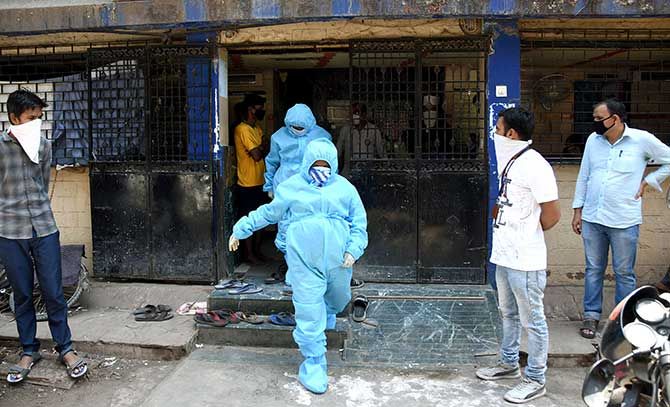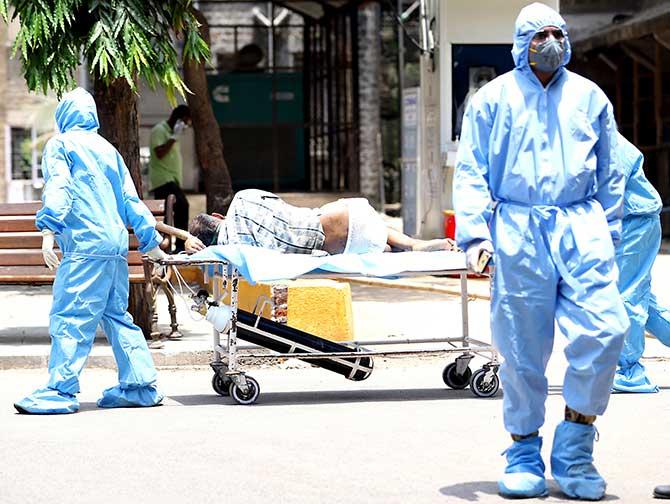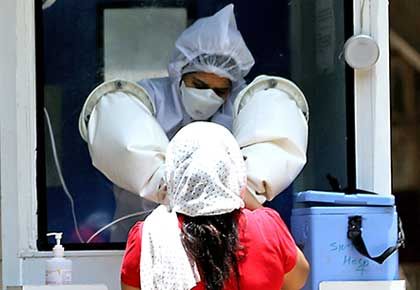 | « Back to article | Print this article |
'There is just one silver lining: The fatality rate has gone down.'

It has been a little over a month since the Maharashtra government prudently appointed a medical taskforce to help it fight COVID-19 in the state.
Dr Sanjay N Oak, who heads the nine-member team, 36 days later, crisply gives Vaihayasi Pande Daniel/Rediff.com an update on the progress in the greater Mumbai urban area. The first part of the interview:
His update offers critical details on:
Dr Oak, a pediatric surgeon, is the CEO of the Prince Aly Khan Hospital in south central Mumbai.
Before that, he racked up nearly four decades of experience working in senior/senior-most positions at three of Mumbai's civic-run hospitals -- the King Edward Memorial Hospital, the Lokmanya Tilak Municipal General Hospital (Sion Hospital) and the B Y L Nair Hospital.
When I spoke to you last, the medical task force you head had just been set up and you were putting together the topmost medical measures to be suggested to the Maharashtra government to fight COVID-19.
You mentioned then that your team had put together a 50-page report.
How has that report been augmented and what are some of the newest, latest measures that you have suggested?
Yes, the last time when we spoke, the report was 50 pages.
Now I think it is about 100 pages plus.
The task force activities continue.

We meet almost every alternate day or night, in a video meeting.
And we discuss every probable thing, that is being performed in any corner of the world -- debate its practicality, discuss its acceptance, dilate about the concept that has been put across, and decide whether it can be included in the recommendations or not.
That even includes suggestions from our colleagues from the aayush (Ayurvedic) fraternity.
We include everything as a part of this document.
We may not recommend it, but you will find it in the task force record, a small paragraph or at least two lines about various things that were suggested.
Just now we are focusing on four important drugs -- remdesivir, favipiravir. tocilizumab, itolizumab.
So, these are the four drugs, which are of paramount significance.
We are urging the government for their early acceptance, early production and applicability to the Indian populace.

As the head of the medical task force in Maharashtra, what are some of the measures you are focusing on?
Especially, to help the containment of COVID-19 in Mumbai's slums.
The slums, naturally because of their structure, would be posing severe limitations in the fight against this virus in the city?
We need to continue the screening and scanning of the Mumbai slums in larger proportions, which we are doing.
If I could give you some statistics: In the last about 10 days, in 24 administrative wards of Mumbai, we have scanned approximately about 30 lakhs of people, with pulse oximetry (a test that uses a small device to measure the oxygen in the blood. At sea level a healthy person should have oxygen saturation or sats of 96 to 99 per cent and at least above 94 per cent. Less indicates comorbidity of some kind).
We found at least about 1,100 individuals, who were over the age of 55, whose pulse oximetry readings were unsatisfactory and who had comorbidities.
So, they were moved into the CCC (COVID-19 care centres) arenas, given oxygen and treatment.
Now this is useful, because I would consider them as a vulnerable group.
For this vulnerable group, it was like putting the stitch in at the right time.

Secondly, we are increasing the number of beds in Mumbai.
Everywhere. Public sector. Private sector.
We have constructed big, big hospitals and this is happening in a very coordinated manner.
This on a scale that Mumbai is witnessing for the first time.
I've been in clinical medicine, surgery and the health sector for last 40 years and 15 years in administration.
I haven't seen something to the tune of an 1,000 bed hospital being built in 10 days.
This is happening right in our own times.
And I feel happy about that.
 IMAGE: Dr Sanjay N Oak. Photograph: Kind courtesy sanjayoak/Facebook
IMAGE: Dr Sanjay N Oak. Photograph: Kind courtesy sanjayoak/FacebookHowever, I feel that let most of these beds remain empty.
I would be happy to construct a bed and keep it empty.
Because that means that the disease is really under control.
At the hospital level, yes, the ICU beds are in high demand.
And all walks of society -- whether rich, ultra-rich, and even the poor -- are finding it tough to find ICU beds, because they are limited.
That is definitely a matter of concern for all of us.
And then when it comes to the new drugs which we want to use - the costs should not limit it.
And the availability should also be there, so that it becomes accessible to the needy people.
These are some of my steps now in Mumbai.

When will COVID-19 cases peak in Mumbai?
I think we are very close to the peak.
I can say that with conviction looking at the number of cases which are being diagnosed every day.
There is just one silver lining: The fatality rate has gone down.
In fact, on April 13, when the task force was set up and we started our work, the fatality rate was almost to the tune of about 7.7 per cent.

Right, you told me that.
And the first sentence, that I had uttered, on what would be our first objective, was to try and get it low.
And I'm satisfied that today we are at 3.3 or 3.2 per cent.
But I'm not fully contented, because I want it to even drop down further.
Every day we do hear about 35 to 40 deaths.
And I really, really want to get it down to below 10.
That would be my objective from now on.
And the second important ratio is what is called as the case-doubling ratio.
When we started our work, we were somewhere around 3.8 days, which was very dangerously low.
Today we have the case doubling rate almost at the tune of about 10 or 11 days.
But I would be looking forward to making the case-doubling ratio to about 20.
When 20 happens, then in the city COVID-19 cases will be kind of tapering out.
Production: Ashish Narsale/Rediff.com
